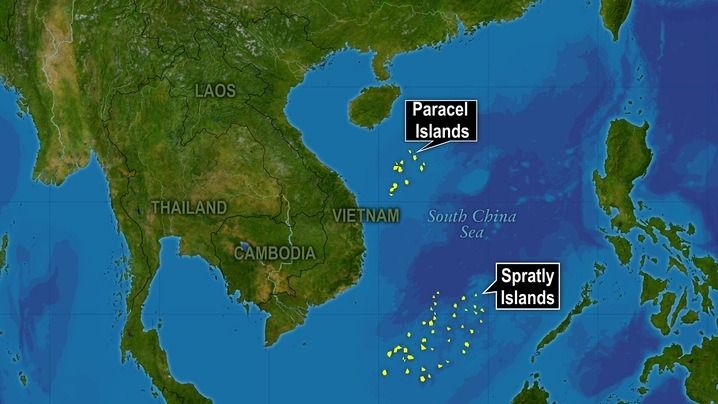Flashpoint in the South China Sea
By Dan Drollette Jr | October 17, 2014

“Considerably more dangerous internationally than Hong Kong or Tibet is the problem of the South China Sea… The Seventh Fleet needs to be strengthened sufficiently to guarantee continued free passage through the South China Sea and all Southeast Asian sea lanes.” The words sound like they could have come from today’s headlines, especially after the recent BBC article, “Why is the US Navy Practicing for War with China?”
But these sentences actually appeared 17 years ago, in a Bulletin of the Atomic Scientists story by Chalmers Johnson, a professor of Asian Studies at the University of California at San Diego, who noted the significantly increased defense budgets of nations in this forgotten area—and the fact that China had massively upped the ante by claiming the entire South China Sea and authorizing its navy to evict trespassers by force. “These actions offered a compelling argument for a continued American naval presence in East Asia,” he wrote in his 1997 Bulletin story, “The Chinese Way.”
(Johnson was hardly a blood-and-guts saber-rattler; the New York Times described him as a scholar who stirred controversy by contending that the United States was trying to use its military presence to gain control over the global economy at the expense of American democracy; one of his books was titled Blowback: The Costs and Consequences of American Empire.)
Then and now, China’s claims are based upon the disputed ownership of a distant chain of tiny, thinly inhabited islands known as the Spratlys and another far-off chain known as the Paracels, that together occupy a very remote part of ocean. The Spratlys are made up of about 750 little bits of land—formations of rock that barely poke above the water at extreme low tide, atolls, cays, and full-blown islands—that lie due south of China and southeast of Vietnam. (The Paracels have fewer islands, in a more compact region, but with more landmass.) Both archipelagos have indications of reserves of natural gas and oil around them. Both countries fervently claim the island chains as their own, as do the governments of the Philippines, Malaysia, Brunei, and Indonesia.
But China has been extending the size of its claims significantly, far beyond its shores, in some cases right up to the coasts of neighboring countries. In a new twist, the country’s leadership is using increasingly novel methods to nail down their claim.
Under international law, by staking its flag on a tiny dot of land, a country may hold title to all the ocean waters, shipping channels, seabeds, and their contents within a 200-mile radius. In the case of the tiny Paracel archipelago, ownership of a 3 square-mile landmass could theoretically lay the basis for a claim to the rights to about 5,800 square miles of ocean and the minerals beneath. Using similar logic, China says that 350,000 square miles surrounding the more spread-out Spratly island chain belong exclusively to China. Just as important as the mineral rights, controlling these specks of land means control of the South China Sea, the shipping gateway to East Asia.
With a resurgent and more belligerent China building a deep-water navy—and possibly supported by a newly developed Chinese missile, called the DF-21D, “built to strike a moving ship up to about 1,700 miles away,” according to the Wall Street Journal—these tiny island chains are becoming an increasing source of friction between that nation and its neighbors. There have been bloody clashes between China and Vietnam over this pair of archipelagos in the past few decades and standoffs between China and the Philippines.
And China has been steadily pushing for more territory. The country’s leadership has made hints in the past about projecting claims farther out into the Pacific to the “Second Island Chain”—which would even take in Guam, nearly 2,000 miles from Shanghai, and home to a huge US naval base, the US Pacific Fleet, and a US submarine squadron, among other military assets.
It all sounds a lot like the jockeying for position that occurred in the Pacific in the 1930s, when Japan was taking over similar atolls and the United States responded by sending in construction crews (and a detachment of Marines) to develop places such as Wake Island, ostensibly as refueling stops for Pan American Airways' flying boats. Later, Wake became a memorable battleground in the opening days of World War II.
In the latest development in the South China Sea competition, China is now trying to cement its claim to the Spratlys by hauling in millions of tons of rock and sand to create new land, at a cost of billions of dollars. So, for example, what was once a submerged reef in the Spratlys just below the waterline (Johnson South Reef) is now an island, occupied and claimed by China—and on which, the Philippine government says, China will build an air base, creating what would effectively be an unsinkable aircraft carrier and a new set of facts on the ground. (The proposed design of the Chinese military complex can be found in a Philippine newspaper.) Johnson South Reef is nearly 800 miles from the Chinese mainland; Vietnam and the Philippines are only about 200 miles away.
China is using this island-creating approach in multiple places; an extensive, in-depth BBC multimedia feature reporting from the Spratlys memorably describes the endeavor as “China’s Island Factory,” through which the Chinese hope to carve new ground. Literally.
Editor’s note: The full archive of Bulletin print issues—from 1945 to 1998 and complete with covers and other illustrations—is available here.
Together, we make the world safer.
The Bulletin elevates expert voices above the noise. But as an independent nonprofit organization, our operations depend on the support of readers like you. Help us continue to deliver quality journalism that holds leaders accountable. Your support of our work at any level is important. In return, we promise our coverage will be understandable, influential, vigilant, solution-oriented, and fair-minded. Together we can make a difference.
Topics: Analysis, Special Topics, Technology and Security















